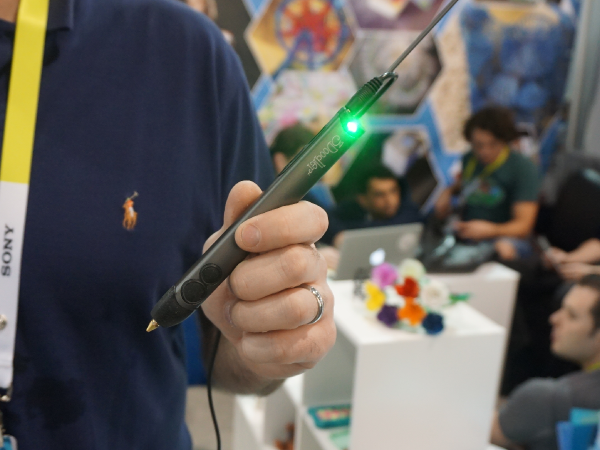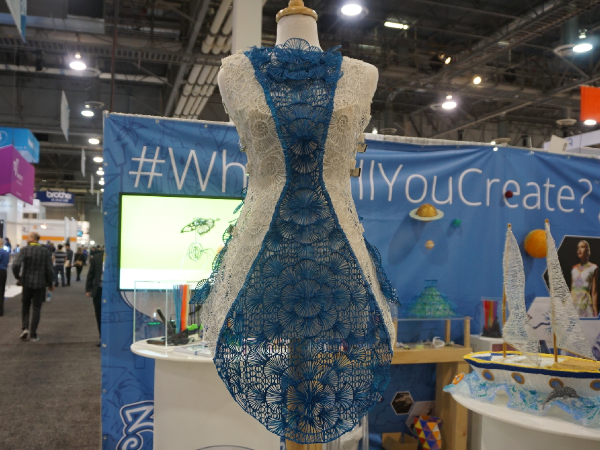3Doodler 2.0 Draws Impressive 3D Sculptures
With its lighter design and faster cooling system, the 3Doodler 2.0 lets users "draw" beautiful 3D designs and sculptures into being.

LAS VEGAS - "Drawing" three-dimensional objects is not only possible, it's easier than ever with the 3Doodler 2.0. This cross between a pen and a 3D printer extrudes fast-drying plastic to let users imagine just about any object into existence.
Debuting at the Consumer Electronic Show (CES) 2015 and on Kickstarter for a 20-day fundraising campaign, the 3Doodler 2.0 can be preordered now for $85. I checked out the 3Doodler 2.0 at the show, and was amazed not only at the device itself, but at the amazing figures, decorations and even fashion that the 3Doodler had been used to make.
MORE: Best 3D Printers
The new 3Doodler 2.0 is slimmer and quieter than its first-generation predecessor: its biggest new feature is an improved fan system, which lets it cool the extruded plastic in a matter of seconds.
To start up the 3Doodler, either press and hold a button near the base of the pen, or double-click this button to start up a continuous flow of plastic without having to constantly depress the button. To top the plastic in this mode, either press down on the button, or tap it once. The continuous flow mode will prevent sore and cramped fingers among 3Doodler power-users who doodle for hours.
Doodling with the 3Doodler is much slower than doodling with a regular pen: you need to move the device slowly, as the plastic needs a few seconds to cool. Nevertheless, a 3Doodler representative was able to create vertical standalone lines of three or four inches within thirty seconds.
The 3Doodler has two settings: high temperature (good for printing in plastics such as ABS) and low temperature (for materials such as PLA). To power the device, users can either plug it in via a long cord to an electrical outlet, or doodle on the go with a new portable battery pack called a JetPack. The company claims the JetPack can last for up to tnree hours of continuous doodling on low temperature, and up to two hours when doodling on high temperature. On Kickstarter, a 3Doodler 2.0 bundle including the JetPack costs $150.
Get instant access to breaking news, the hottest reviews, great deals and helpful tips.
The print filament comes in stiff plastic rods like spaghetti, and are loaded into the back of the 3Doodler similar to a hot glue gun. If you want to change colors while doodling, all you have to do is put a new color into the back, and when the first filament runs out the 3Doodler will seamlessly transition to the second.
In addition to printing in ABS and PLA plastics, the 3Doodler 2.0 can also print in new materials such as Flexi, a flexible plastic material. A 3Doodler representative showed me his wallet, which was almost entirely "doodled" in Flexi material so it could be opened and closed.
But even the wallet was far from the coolest "doodle" at the booth: tables were full of amazing objects designed with the 3Doodler, from statues of baby Groot from Guardians of the Galaxy, to models of Notre Dame cathedral, even to a life-sized and quite stylish-looking dress.

Amidst these amazing creations, all I managed in my five minutes with the device was a little spindly glob, the 3D equivalent of a scribble. But that probably has more to do with my total lack of artistic ability than any fault of the 3Doodler 2.0; I found the pen easy to handle.
Kickstarter backers who ordered the Early Bird version of the 3Doodler 2.0 (already sold out) will receive their devices in about a month. Other purchasers will get the device in April.
- The Weirdest and Wildest 3D Printers
- 3D Printing Service Reviews – Cubify, Shapeways & More
- 3D Printing Gets Boost With New Materials
Jill Scharr is a staff writer for Tom's Guide, where she regularly covers security, 3D printing and video games. You can email Jill at jscharr@tomsguide.com, or follow her on Twitter @JillScharr and on Google+. Follow us @tomsguide, on Facebook and onGoogle+.
Jill Scharr is a creative writer and narrative designer in the videogame industry. She's currently Project Lead Writer at the games studio Harebrained Schemes, and has also worked at Bungie. Prior to that she worked as a Staff Writer for Tom's Guide, covering video games, online security, 3D printing and tech innovation among many subjects.
